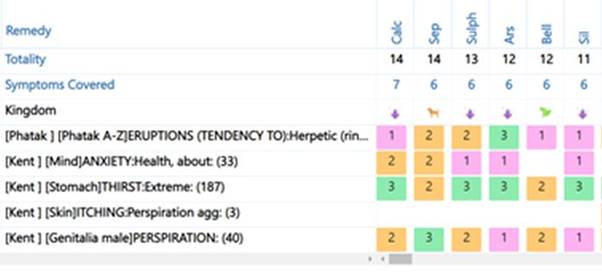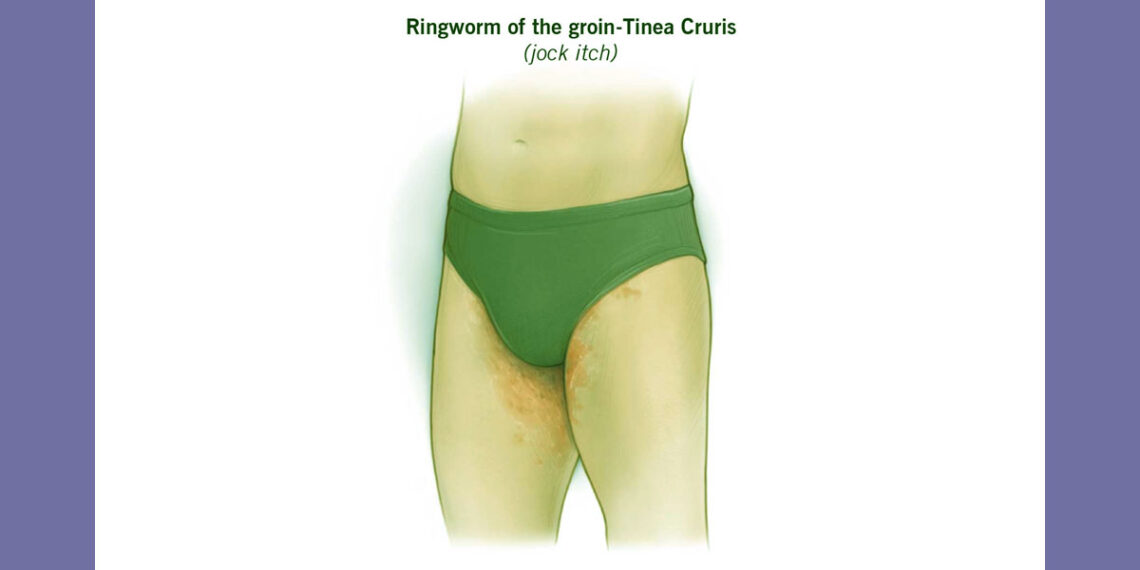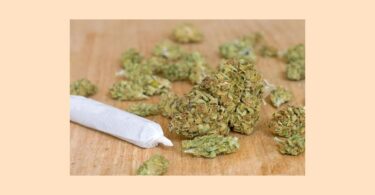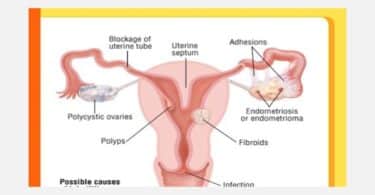Abstract: Tinea infections are among the most common skin diseases worldwide and cause serious chronic morbidity. Although it is not life threatening it can cause distress to the patient. The scope of conventional treatment is limited as the topical and oral antifungal agents only suppress the condition and recurrences are more intensified.
Homeopathy is known to be the most popular treatment modality for skin problems. The constitutional approach always yields wonderful results with no recurrences.
Keywords: Homeopathy, tinea, ringworm, dermatophytes, fungal, skin, Arsenicum album
Introduction:
The term ‘Tinea’ refers to superficial infection of skin, hairs and nails caused by pathogenic fungi known as dermatophytes, belonging to three genera, Trichophyton, Epidermophyton and Microsporum. Dermatophytic infection of skin is often called as “ringworm”.
Dermatophytes manifest in humans in various forms and the most common are Tinea corporis and Tinea cruris most commonly caused by Trichophyton species. According to the WHO, the superficial mycotic infection has a prevalence rate of 20-25% worldwide. It is more prevalent in tropical and subtropical countries like India where the heat and humidity is high for most of the year.
Classification of tinea on the basis of location involved:
| Tinea capitis | Ringworm of scalp |
| Tinea faciei | Face |
| Tinea barbae | Beard |
| Tinea manuu | Wrist |
| Tinea corporis | Ringworm of trunk |
| Tinea cruris (jock’s itch) | Ringworm of groin |
| Tinea pedis (athlete’s foot) | Ringworm of foot |
| Tinea unguium (onchomycosis) | Nail fungus |
The fungi affects keratinized tissues and spreads by direct contact with infected human beings, animals, soil and indirectly by fomites.
Clinical Presentation of tinea lesions:
The gross appearance of the lesion is an outer ring of active, progressing infection, with central healing. Infection may proceed more deeply from superficial involvement, depending on the fungus, site of infection, and immune status of the host.
Among all, Tinea corporis is the commonest clinical type.
Tinea capitis is predominantly seen in pre-pubertal children. Tinea cruris occurs only in adults especially the males and rarely in children. Tinea pedis and Tinea unguium, Tinea corporis are more common among adults
Risk factors:
Several risk factors have been identified that predispose an individual to tinea infection, including moisture (humid weather, excessive perspiration), occlusive clothing, unhygienic conditions, diabetes mellitus, immunocompromised state, and lower socioeconomic status.
Diagnosis based upon the appearance:
On physical examination, an erythematous, scaly, annular plaque with a raised leading edge and central clearing can be visualized involving the groin region. The infection spreads centrifugally and results in annular patches of varying sizes.
Tinea infections may mimic other conditions, which can manifest identical lesions, sometimes making the clinical diagnosis unreliable. For example, tinea corporis can be confused with eczema, tinea capitis can be confused with alopecia areata, and onychomycosis can be confused with dystrophic toenails, which may result from repeated low-level trauma. The confirmatory test could be done with a potassium hydroxide preparation or culture.
Points to be considered while treating Tinea cruris:
The pruritic rash of tinea is sometimes accompanied with secondary infections which results in much irritation, inflammation, pain and discomfort which needs extra care. Other conditions which may be responsible for the maintenance and prolongation of infection like history of diabetes, immunocompromise, renal disease, or hepatic dysfunction must be elucidated.
Enquiry should be made about excessive sweating, wardrobe changes, and personal hygiene habits, patient’s environmental and occupation exposures, including people, pets, animals, and contaminated soil, which may be contributory to the skin condition.
This information could help you in management of the case in better way; helps in removing exciting or maintaining cause if any and provide effective treatment which will give relief to the patient that will sustain and help avoid recurrences.
Case report:
Introduction
Mr D, aged 28 years, unmarried man came to me on 1st January 2022 with the complaint of annular eruptions on the inner sides of thighs and genitalia for 3 years. He is frustrated with the itching and offensiveness of it.
Presenting complaints
The chief complaint of the patient was itchy annular eruptions on the inner sides of thighs and genitalia which is horribly offensive. The itching aggravates by perspiration and after having eggs.
History of presenting complaints
The patient was apparently well 3 years back then he noticed circular, inflamed itchy eruptions on the sides of thighs which slowly increased over the genitals.
Treatment history: Consumed many anti-fungal oral medications in the past but with no relief. Used antifungal ointments too with temporary relief.
Past history: Nothing Specific
Family history: Nothing specific was found
Physicals generals
The patient’s appetite was moderate, thirsty. Desires for sour things. He perspires more on genitals. Chilly patient.
Mental generals
Patient is very irritable due to extreme itch, bursts out in anger and shouts. He has marked anxiety about his health and used to go for laboratory investigations on frequent basis. Full of fears, fear of getting infected or illness and very anxious. He doesn’t like to be alone, desires company.
Analysis and Evaluation of symptoms
After detailed case taking, proper analysis and evaluation of the symptoms was done to construct the totality. The following characteristic, uncommon, peculiar symptoms which includes mental and physical generals as well as particular symptoms were considered for repertorization.
| Mental Generals | Physical Generals | Particulars |
| Irritability, shouts in anger+
Anxiety about health+++
Fearful, anxious++ |
Thirst- increased
Desire for sour things+
Perspiration on genitals+
Chilly patient |
Ringworm, Itching over the sides of thigh, genitals ++
Offensive+++
< Perspiration, egg++ |
Symptoms considered for Repertorization using Homeopath were:
- Eruptions (tendency to): Herpetic (ringworm)
- Mind – Anxiety: Health, about
- Stomach- Thirst: Extreme
- Skin- Itching: Perspiration aggravates
- Genitalia- Male, Perspiration
- Stomach- Desires: sour, acids etc.
- Mind- irritability
- Mind- Delirium: frenzy, anxious, fearful etc.
Repertorial Result

Selection of remedy with justification:
The repertorial result showed the highest ranked remedies which includes Calcarea, Sepia, Sulphur, Arsenic and Belladonna. Among these remedies, Arsenic was selected as the individualized constitutional medicine.
The reason was that the general constitution and mental picture of the patient was very much similar to Arsenicum album, covering his anxiety, irritability and fear. After considering materia medica, Arsenicum was covering most of his symptoms and found to be a useful remedy for ringworm as described in materia medica. According to the totality of the symptoms, a single dose of Arsenicum album 200CH was prescribed considering the susceptibility of the patient.
Prescription
Arsenicum album 200CH, single dose
Followed by placebo 30, thrice a day for 15 days.
Follow -UPs
| Date | Symptoms | Prescription | Justification |
| 18th Jan 2022 | Patient was feeling much better with a sense of relief upto 80% | Rubrum met 30 | Prognosis : good
Next step should be “Wait & watch” |
| 11th Feb 2022
|
Patient is relieved of his suffering, Skin eruptions have cleared up, no residual eruptions or itching present. | Rubrum met 30 | Wait & watch |
| 5th July 2022 | As the patient was relieved completely of his skin complaints he stopped taking medicines. Therefore, telephonic follow up was taken & the patient reported that he is doing great without any reappearance of skin eruptions. | No recurrence was noticed. |
Conclusion
Homeopathy gives promising results in dermatological cases. Homeopathy treats the patient as a whole, not just the disease. It targets the root cause; hence prevents recurrences. Individualisation plays the major role in the selection of most similar remedy. Patients may respond well to the constitutional remedy than to a specific or therapeutic remedy.







Why did you tell us the remedy you gave at the beginning? This completely spoilt being able to try to work it out ourselves!
Karina, I hear you! I always wait to the end of the case before revealing the remedy. I’m sorry others aren’t getting the message.